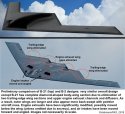New B-21 Bomber or B-2 Mod 1?
The US Air Force has published
of the next-generation bomber, formerly known as LRS-B (Long Range Strike Bomber). Air Force Secretary Deborah Lee James revealed the image
and gave it its official designation: B-21.
The “21” refers to the 21st Century and is intended to signal cutting-edge technology and capability. (Last time the Pentagon named a major defense program after the 21st Century was the SSN-21, the Navy’s Seawolf-class attack submarine. That program was canceled after only three boats.)
But just how different the B-21 is remains to be seen. The B-21 image shows the new bomber is not a significantly new design but looks more like an upgrade of the B-2. The main focus may have been to improve stealth and sensors. The Air Force has promised to disclose more details in March. They’ll certainly have to, if they want all the money they’re asking for it.
Preliminary Design Comparison
A preliminary comparison of the B-21 and B-2 bomber images suggests a very similar overall design, perhaps a little smaller, but with some significant modifications.
The most apparent difference is that the B-21 has a clean diamond-shaped center body section in contrast to the B-2’s more jagged rear center wing outline. The indents in the B-2’s rear center wing were created by the engine exhausts, a design feature that appears to be absent from the B-21. Engine exhaust is an important source of detectable heat. It is unknown if the engine exhausts have been moved below the body, integrated better into the edge of the wing, or omitted from the drawing because it is still a secret.

And the wings on the B-21 appear a little more backswept than the wings on the B-2 resulting in a pointier aircraft nose, although that could be an optical illusion from the the quality of the images.
Another difference is that the air-intakes of the two engines have been extended forward and the edges angled, presumably to further reduce the aircraft’s radar signature.
Whatever else is “hidden under the hood,” the Air Force says that the design “allowed for the use of mature systems
and existing technology while still providing desired capability” but with “an open architecture allowing integration of new technology and timely response to future threats across the full range of military operations.” (Emphasis added.)
It Doesn’t Have A Name
The new bomber has a designation (B-21) but not yet a name. The B-2 is called the Spirit. The B-52 is called the Stratofortress. The B-1 is called the Lancer. So Secretary James
to come up with a name. There are already many suggestions – some serious, some gung ho, others highly critical:
and there is a growing list of suggestions in the comments to
. Just to mention a few:
Spirit II, Deliverance, Thunderbolt, Sand Melter, Nightwing, Stormbringer, Flying W, Batwing, The Obama, Lemay, Regurgitating Pigeon, Flying Money-Pit, 2-Bad (the Cold War never really ended), Boondoggle, Budgetbuster, or Another Flying Turd from Northrop Hunk Of Overpriced Under-Performing Long Delayed Useless Waste of Taxpayers Money.
Or how about Resurrection? The Air Force didn’t get its 132 B-2 bombers, only 21 because they were too expensive. So now the Air Force tries again with what looks like a modified B-2: the B-21.
Looming Costs
The Air Force
each B-21 will “only” cost $564 million (in FY2016 money) plus $23.5 billion for overall program development, or a total of nearly $80 billion for 100 bombers.
The Air Force also
the average procurement cost of each B-21 will be approximately a third of what the B-2 cost was.
These cost projections are already being met with considerable skepticism. Based on the Air Force’s own projections, according to
, the cost of major Air Force aircraft programs “is projected to peak in FY2023 at nearly twice the FY2015 level of funding, adjusting for inflation, and is a driving factor behind the overall defense modernization bow wave.”
Senator John McCain, the chairman of the Senate Armed Services Committee that has to approve B-21 funding, has already
to key provisions in the current B-21 contract. This should make for some interesting hearings on the Hill later this spring.
And new defense programs historically
, which would put further pressure on the Air Force’s budget.
If so, the total cost for developing and producing 100 B-21 bombers might reach $96 billion to $104 billion. Oh, and don’t forget to add the costs of integrating
nuclear guided bomb and
on the B-21 as well.
I just wonder what the Air Force’s fallback plan is. Delay? Fewer bombers? Less advanced design? Fewer fighters? Fewer satellites? Fewer tankers? No LRSO? Fewer ICBMs? Absent a major infusion of additional money into the defense budget, the Air Force’s current modernization plan seems unsustainable.


